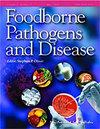Virulence Genes, Antimicrobial Resistance, and Genotypes of Campylobacter jejuni Isolated from Chicken Slaughterhouses in South Korea.
IF 1.9
2区 农林科学
Q3 FOOD SCIENCE & TECHNOLOGY
引用次数: 0
Abstract
Campylobacter jejuni represents one of the leading causes of bacterial gastroenteritis in humans and is primarily linked to chicken meat contamination. In the present study, we analyzed the virulence and survival genes, antimicrobial resistance, and the clonal distribution of 50 C. jejuni isolates obtained from various sources in 14 chicken slaughterhouses across 8 provinces in South Korea from 2019 to 2022. Furthermore, we determined their genetic relatedness to human-derived isolates registered in PubMLST using multilocus sequence typing (MLST). All isolates harbored various virulence and survival genes (flhA, cadF, cdtA, cdtC, cmeA, and sodB) out of 17 tested genes, as confirmed via polymerase chain reaction analysis. Adherence factor gene virB11 was not detected in any isolate. All isolates harbored 12 or more virulence and survival genes. Antimicrobial susceptibility testing indicated that ciprofloxacin resistance was the most prevalent (84.0%), followed by nalidixic acid (82.0%) and tetracycline (52.0%) resistance. MLST analysis of the isolates revealed 18 sequence types (STs), including four new ones. Overlapping STs between chicken slaughterhouse and human-derived isolates included ST42, ST45, ST50, ST137, ST354, and ST464. Our study identified 11 clonal complexes (CCs), with CC-21 being the most prevalent in both human and chicken slaughterhouse-derived isolates. This study provides comprehensive insights into recent C. jejuni isolates from chicken slaughterhouses, including data on quinolone resistance and virulence factors. The MLST-based genetic relatedness between isolates from humans and chicken slaughterhouses in this study suggests the potential of C. jejuni transmission from chickens to humans through the food chain. This study suggests the need for improved management practices in chicken slaughterhouses to reduce the transmission of chicken slaughterhouse-derived C. jejuni to humans.从韩国鸡屠宰场分离的空肠弯曲杆菌的毒力基因、抗菌药耐药性和基因型。
空肠弯曲菌是导致人类细菌性肠胃炎的主要原因之一,主要与鸡肉污染有关。在本研究中,我们分析了 50 株空肠弯曲菌分离物的毒力和存活基因、抗菌药耐药性以及克隆分布,这些分离物来自 2019 年至 2022 年韩国 8 个道的 14 个鸡肉屠宰场的不同来源。此外,我们还利用多焦点序列分型(MLST)确定了这些分离株与在 PubMLST 中登记的人源分离株的遗传亲缘关系。经聚合酶链反应分析证实,所有分离株都携带了17个检测基因中的各种毒力和存活基因(flhA、cadF、cttA、cttC、cmeA和sodB)。在任何分离株中都没有检测到粘附因子基因 virB11。所有分离物都携带有 12 个或更多的毒力基因和存活基因。抗菌药敏感性测试表明,环丙沙星耐药率最高(84.0%),其次是萘啶酸(82.0%)和四环素(52.0%)耐药率。对分离物进行的 MLST 分析发现了 18 种序列类型(ST),其中包括 4 种新类型。鸡屠宰场和人源分离物之间重叠的 ST 包括 ST42、ST45、ST50、ST137、ST354 和 ST464。我们的研究发现了 11 个克隆复合体(CC),其中 CC-21 在人类和鸡屠宰场分离物中最为普遍。这项研究提供了对最近从鸡屠宰场分离到的空肠大肠杆菌的全面了解,包括喹诺酮类药物耐药性和毒力因子的数据。本研究中来自人类和鸡屠宰场的分离物之间基于 MLST 的遗传相关性表明,空肠大肠杆菌有可能通过食物链从鸡传染给人类。这项研究表明,有必要改进鸡屠宰场的管理方法,以减少鸡屠宰场产生的空肠大肠杆菌传播给人类。
本文章由计算机程序翻译,如有差异,请以英文原文为准。
求助全文
约1分钟内获得全文
求助全文
来源期刊

Foodborne pathogens and disease
医学-食品科技
CiteScore
5.30
自引率
3.60%
发文量
80
审稿时长
1 months
期刊介绍:
Foodborne Pathogens and Disease is one of the most inclusive scientific publications on the many disciplines that contribute to food safety. Spanning an array of issues from "farm-to-fork," the Journal bridges the gap between science and policy to reduce the burden of foodborne illness worldwide.
Foodborne Pathogens and Disease coverage includes:
Agroterrorism
Safety of organically grown and genetically modified foods
Emerging pathogens
Emergence of drug resistance
Methods and technology for rapid and accurate detection
Strategies to destroy or control foodborne pathogens
Novel strategies for the prevention and control of plant and animal diseases that impact food safety
Biosecurity issues and the implications of new regulatory guidelines
Impact of changing lifestyles and consumer demands on food safety.
文献相关原料
| 公司名称 | 产品信息 | 采购帮参考价格 |
|---|
 求助内容:
求助内容: 应助结果提醒方式:
应助结果提醒方式:


